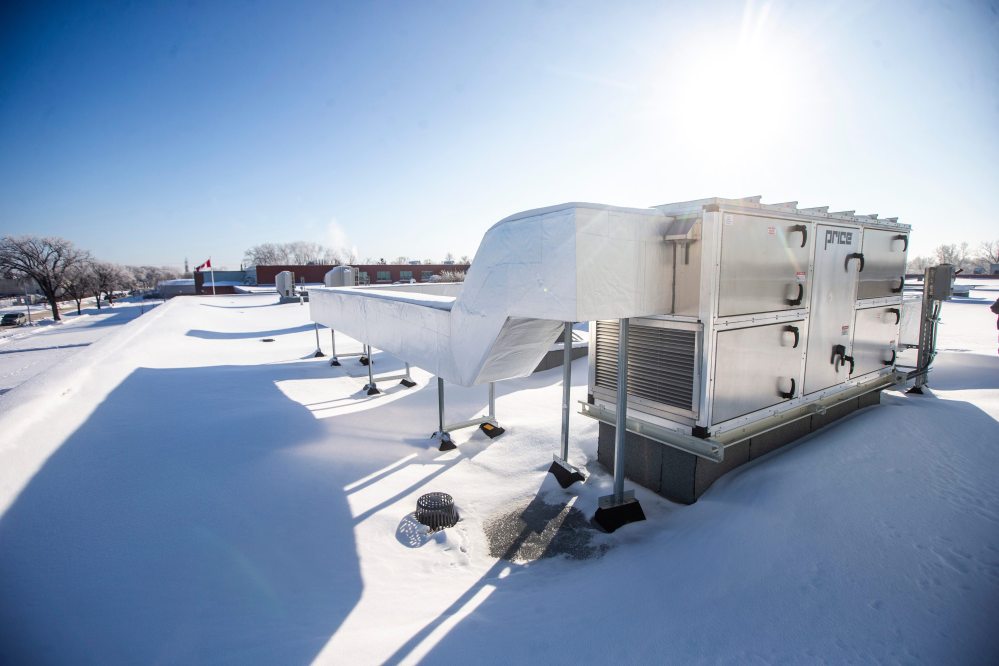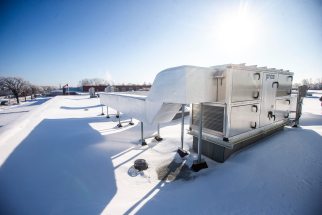Schools tossed some air-quality-improvement cash into the wind, experts say More than a quarter of pandemic-focused funds have been used for ineffective duct-cleaning
Read this article for free:
or
Already have an account? Log in here »
To continue reading, please subscribe:
Monthly Digital Subscription
$0 for the first 4 weeks*
- Enjoy unlimited reading on winnipegfreepress.com
- Read the E-Edition, our digital replica newspaper
- Access News Break, our award-winning app
- Play interactive puzzles
*No charge for 4 weeks then price increases to the regular rate of $19.00 plus GST every four weeks. Offer available to new and qualified returning subscribers only. Cancel any time.
Monthly Digital Subscription
$4.75/week*
- Enjoy unlimited reading on winnipegfreepress.com
- Read the E-Edition, our digital replica newspaper
- Access News Break, our award-winning app
- Play interactive puzzles
*Billed as $19 plus GST every four weeks. Cancel any time.
To continue reading, please subscribe:
Add Free Press access to your Brandon Sun subscription for only an additional
$1 for the first 4 weeks*
*Your next subscription payment will increase by $1.00 and you will be charged $16.99 plus GST for four weeks. After four weeks, your payment will increase to $23.99 plus GST every four weeks.
Read unlimited articles for free today:
or
Already have an account? Log in here »
Hey there, time traveller!
This article was published 05/01/2023 (1074 days ago), so information in it may no longer be current.
More than $3 million set aside to improve air quality in schools during the COVID-19 pandemic has been spent on duct cleaning — a measure not backed by research as an effective way to limit infectious-disease transmission.
Manitoba earmarked nearly $11.3 million, including provincial and federal pots of about $6.8 million and $4.5 million, respectively, to upgrade ventilation systems in K-12 buildings.
Data obtained by the Free Press via freedom of information request shows 94 per cent of those funds had been allocated at the start of the 2022-23 school year. (See where all the money went in the chart at the bottom of this story.)
The largest chunk of money disbursed to date has been for duct cleaning, a process that removes dust, mould and rodent droppings from heating, ventilation and air conditioning systems.
Major renovations and moisture problems are what typically warrant the service, and it alone does not directly address the risk posed by COVID-19, said Jeffrey Siegel, a University of Toronto professor of civil engineering who studies indoor air quality.
“If (schools) are really going to benefit from a duct cleaning, it’s going to be because things are so bad that air can’t flow because the vents are dirty,” Siegel said.
The sheer sum spent on flushing vents, as well as air balancing and testing, suggests there is “a huge deferred maintenance program,” he said, noting it appears as though routine checks have been underfunded and overlooked.
“If (schools) are really going to benefit from a duct cleaning, it’s going to be because things are so bad that air can’t flow because the vents are dirty.”–Jeffrey Siegel
While much of the money in the ventilation fund has gone towards general servicing, approximately $2.1 million has been spent on air filters and purifiers.
The government dollars also covered the installation of new CO2 sensors, updated gauges on HVAC units, ultraviolet equipment, bathroom fan upgrades and heating coil pressure washing, along with other smaller projects.
A $5,000 grant for “opening windows” at Elton Collegiate, a rural high school 15 kilometres north of Brandon, is an oddity in the provincial data. Jason Cline, superintendent of the Rolling River School Division, could not be reached this week to provide a more detailed explanation of the work.
In total, 29 public school divisions and 18 partially-funded independent schools were chosen as recipients.
The Winnipeg School Division, the province’s largest, received the biggest chunk — $2.5 million worth of projects across 78 facilities.
WSD’s École Secondaire Sisler High, which boasts an enrolment of about 1,700, making it Manitoba’s biggest school, was granted the largest amount for upgrades.
It cost more than $175,000 to clean ducts and coils, update air filters, conduct an air balancing report, install air purifiers in nine portable classrooms, introduce CO2 duct sensors in 22 air-handling units and hire an engineering consultant to review data at the Redwood Avenue site.
Provincial officials circulated protocols to improve classroom air quality, based on the American Society of Heating, Refrigeration and Air Conditioning Engineers’ Reopening Guide for Schools, in August 2021.
The international guide — finalized one year earlier, just before Manitoba students restarted in-person classes in the fall of 2020 — touts boosting a building’s intake of outdoor air to dilute contaminants indoors as “a first line of defence against aerosol transmission.”

It also recommends pre- and post-occupancy purge cycles to flush a building with clean air and ensuring high-efficiency filters are installed, along with the completion of preventative and deferred maintenance to potentially improve overall indoor air quality.
Matthew Froese, a mechanical engineer in building commissioning, noted duct cleaning was not part of industry guidance for building reopening and it’s not something his firm is usually worried about because dust doesn’t tend to move once it has settled.
Froese said basic maintenance, however — even though it may not sound exciting — can be very effective at improving overall air quality.

“If you have a ventilation system that’s installed but something has broken, fixing the broken piece might be the best bang for your buck,” said Froese, of Winnipeg-based Integrated Designs Inc.
The engineer used cleaning heating coils — a service undertaken in at least 40 local schools since March 2020 — as an example. This process, involving the removal of organic debris in a ventilation system, can make a significant difference in restoring air flow, he said.
“If you have a ventilation system that’s installed but something has broken, fixing the broken piece might be the best bang for your buck.”–Matthew Froese
The average school is between 50 and 60 years old across the province, the Manitoba School Boards Association says.
Association president Alan Campbell said costly retrofits, as well as ongoing testing and cleaning initiatives, are school leaders’ top priorities “under the air-quality umbrella.”
“Regular maintenance through testing and cleaning of one’s heating, cooling and ventilation systems is conducive to promoting better air quality overall,” Campbell wrote in a statement.
“This does not necessarily indicate that these systems are inadequate or in need of further mechanical maintenance — simply that they are able to perform to higher standards if regularly tested and cleaned.”
RUTH BONNEVILLE / WINNIPEG FREE PRESS FILES Manitoba School Boards Association President Alan Campbell.
Just over half of the 771 public and independent schools that receive provincial funding benefited from ventilation-specific dollars to date.
In November 2021, Cliff Cullen, then-education minister, said projects in schools with high levels of community transmission would be prioritized.
Gonzaga Middle School in North Point Douglas, Morden’s Prairie Crossroads School and St. Boniface Diocesan High School in Norwood received the largest amounts, per capita.
“It’s easy for people to look at this and think that it’s a lot of money — about $11 million (overall), but over Manitoba’s 700 schools, that’s not really enough to make a big change in our indoor air quality,” Froese said.
If the province is really serious about improving indoor air quality,a standard for schools and a budget with far more funds to back it up is required, he said.
The Education Department did not respond to Free Press requests for comment.
How much was spent in your child’s school?
Search the database below for information on funding allocations by school, school division and the type of work funded.
Can’t see the searchable database above? Open it in a new window.
maggie.macintosh@freepress.mb.ca
Twitter: @macintoshmaggie

Maggie Macintosh reports on education for the Winnipeg Free Press. Funding for the Free Press education reporter comes from the Government of Canada through the Local Journalism Initiative.
Our newsroom depends on a growing audience of readers to power our journalism. If you are not a paid reader, please consider becoming a subscriber.
Our newsroom depends on its audience of readers to power our journalism. Thank you for your support.
History
Updated on Thursday, January 5, 2023 7:41 PM CST: updates headline












